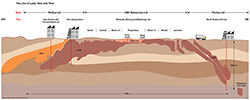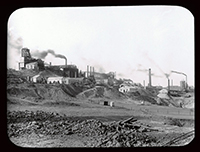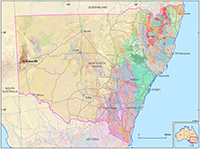News
New visitor experiences showcase the minerals of Broken Hill
Published:18 September 2015
New visitor experiences showcase the minerals of Broken Hill
Genevieve Crutchley, Katy Tomkins and Kate Lehane
A new exhibition and behind-the-scenes tours at Geoscience Australia celebrate the rich mining history of the Broken Hill region, and highlight some of the now rare mineral samples held within Geoscience Australia's mineral collection.
The National Mineral Collection is an impressive selection of some 15 000 mineral and 90 meteorite specimens, of which approximately 600 are on permanent display at Geoscience Australia. The Collection includes a number of distinctive and famous Australian specimens, including some of the unique specimens featured in the 1999 publication 'Minerals of Broken Hill'.
The city of Broken Hill in far western New South Wales is the location of the world's largest lead-zinc-silver deposit. The Broken Hill ore body formed as a result of volcanic activity about 1.7 billion years ago when seawater, heated by the volcanic activity, bubbled up through the sea floor where it encountered the cold ocean water and formed clouds of black sulphide precipitates. These sediments then settled on the sea floor to form layers of sediment rich in zinc, lead and silver sulphide minerals.
Erosion over the past 500 million years has exposed these minerals to weathering. Subsequent exposure to air and groundwater has triggered a series of chemical reactions, generating a suite of new minerals such as smithsonite, azurite and malachite.
The Broken Hill orebody is about 8 kilometres long and shaped like a coat-hanger. The deepest point descends to over 1.5 kilometres underground and outcrops in the centre. The orebody contains a massive sulphide lode of over 200 million tonnes, 50 million tonnes of lead and zinc and 20 000 tonnes of silver.
History of discovery
The Broken Hill ore deposit was first discovered by boundary rider, Charles Rasp in 1883. Rasp worked on Mount Gipps Station and was attracted to a hill on the station after purchasing a prospector's guide while on holiday in Adelaide. He thought that the dark surface of the hill could be a sign of tin oxide. Accompanied by two others, James Poole and David James, he set out for the hill and examined and pegged out the blackest section. His claim became the first mining lease on Broken Hill.
The owner of Mount Gipps Station, George McCulloch, declared he would support the exploration, resulting in the beginnings of Broken Hill mining:
"There's nothing on the hill or if there is you, James and Poole haven't got the money to get the stuff out. You'll have the place rushed if you strike anything. What did you say you'd pegged out? Forty acres. Man, we'll all of us go into it and peg out the whole hill."
In April 1885 rich silver ore was discovered by Thomas Nutt. In early June, the shareholders met and registered the Broken Hill Proprietary Co., more commonly referred to as BHP. On 27 June 1885 William Knox accepted an offer of the secretaryship of the newly formed company. Generally regarded as the brains behind the operation, Knox threw great energy and talent into resolving the company's increasing complexities.
Knox's shaft was sunk on the spot identified by Nutt, where assays of 2000 to 3000 ounces of silver per tonne were subsequently found, guaranteeing the future of Broken Hill. The venture quickly became Australia's wealthiest enterprise and the world's most successful silver-mine. Ore was transported to South Australia by camel trains, wagons and pack mules.
By the late 1880s BHP had only kept Blocks 11, 12 and 13, which had been mined first using shafts, and then by open cut. As BHP's mineral reserves ran out, the company began to consider alternate options for its future. In 1911 BHP decided to build a steelworks, and its interests moved steadily away from Broken Hill. BHP ceased mining operations at Broken Hill in 1939, and left the area in 1942. During its operation the company mined over 250 million ounces of silver, 3 million tonnes of lead, and 2 million tonnes of zinc, making over 60 million pounds of profit for Broken Hill.
Broken Hill has since been mined continuously for almost 120 years. There are now only two operators in this area, both utilising highly efficient bulk underground mechanised mining.
Geoscience Australia's work in the region
Geoscience Australia has worked in the Broken Hill region over many decades to better understand its mineral and water resources.
In the 1990s Geoscience Australia together with the New South Wales government and partners in South Australia began a study to address the long term economic prosperity of the city of Broken Hill. The region was facing an uncertain future, following predictions that the ore body would be exhausted within 10-12 years.
The Broken Hill Exploration Initiative sought to better understand the regional geology and mineral potential of the Broken Hill region in New South Wales and the Olary region in South Australia. The outputs from this project were a geological map and report, documenting the stratigraphy of the region, and papers and presentations at conferences and seminars intended to stimulate interest in the region as an area with further mineral potential.
To highlight the importance of Broken Hill's geological heritage, Geoscience Australia has compiled a public exhibition and tour of stunning mineral samples.
The recently installed Broken Hill Minerals display is now open to the public between 9am and 5pm, Monday to Friday at Geoscience Australia's headquarters in Canberra.
Members of the public are also invited to join a unique behind the scenes tour of Geoscience Australia's Gem, Fossil and Mineral Collection during Earth Science Week (11-17 October).
Further information
Birch, WD & Broken Hill (NSW) City Council 1999, Minerals of Broken Hill, 2nd edn. Editor William D Birch.Broken Hill City Council, NSW.
Worner, HK, Mitchell, RW, Segnit, ER & Australian Mining & Smelting Limited 1982,Minerals of Broken Hill, 1st edn. Australian Mining & Smelting Limited, Melbourne.
Contact:
Phone:
Email:







